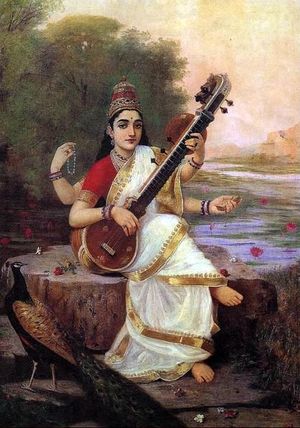Sarasvati: Unterschied zwischen den Versionen
Andip (Diskussion | Beiträge) |
Andip (Diskussion | Beiträge) |
||
| Zeile 12: | Zeile 12: | ||
== Quellen == | == Quellen == | ||
| − | + | * {{Literatur:Daniélou 1964}} | |
| − | Daniélou | + | * {{Literatur:Moor 1968}} |
| − | + | * {{Literatur:Detmold 1979}} | |
| − | Moor | ||
| − | |||
| − | Detmold | ||
Version vom 7. Oktober 2012, 13:03 Uhr
Sarasvatī (Sanskrit, सरस्वती, zu dt. soviel wie "die Fließende"; jap. Benzaiten 弁才天 oder 弁財天) ist die hinduistische Göttin der Musik, Dichtung und der Wissenschaft. In den hinduistischen Religionen gilt sie als Gattin des Schöpfergottes Brahmā und im Buddhismus als Gattin des Bodhisattvas Mañjuśrī. Und obwohl sie heute eine eher untergeordnete Rolle spielt, ist sie eine sehr populäre Göttin, die jährlich bei der Sarasvatī-Pūjā von Schülern und Studenten, Dichtern und Musikern und von Wissenschaftlern verehrt wird.
Sarasvatī ist die Gottheit, die den Menschen die (sanskritische) Sprache und die (Devanāgarī-)Schrift beibrachte und gilt daher auch als die Mutter der Poesie.[1][2]
Sie wird meist zwei- oder vierarmig, aber auch mal achtarmig dargestellt. Am häufigsten ist die zweiarmige Darstellung; hierbei hält sie häufig eine Vīṇā (Biwa in Japan) in ihren Händen. In vierarmigen Darstellungen ist sie häufig mit Musikinstrument (vina), Manuskript, Lotus und Wasserkanne abgebildet.[3]
Seit dem 16. Jahrhundert wird sie in Japan zu den shichi fukujin, den sieben Glücksgöttern gezählt.
Verweise
- ↑ Daniélou, Alain: Hindu Polytheism. London 1964. 260.
- ↑ Moor, Edward: The Hindu Pantheon. Delhi 1968. 67.
- ↑ Detmold, G./Rubel, M.: The gods and godesses of Nepal. A Traveller's guide to the Hindu and Buddhist deities in the Kathmandu valley of Nepal, with a comprehensive glossary to aid in their identification. Kathmandu 1979. 98.
Quellen
- Alain Daniélou 1991The myths and gods of India: The classic work on Hindu polytheism. New York: Bollingen Foundation 1991. (Erste Auflage 1964 unter dem Titel "Hindu Polytheism".)
- Edward Moor 1968The Hindu pantheon. Delhi: Varanasi, Indological Book House 1968.
- Geoffrey Detmold, Mary Rubel 1979The gods and godesses of Nepal: A traveller's guide to the Hindu and Buddhist deities in the Kathmandu valley of Nepal, with a comprehensive glossary to aid in their identification. Kathmandu: Ratna Pustak Bhandar 1979.
